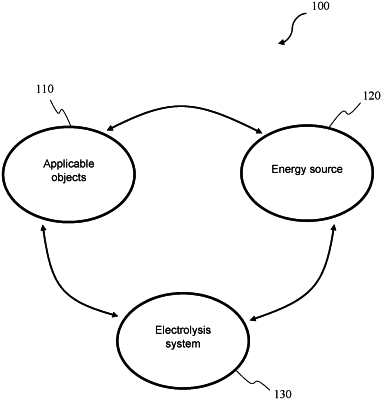| CPC F02D 41/0027 (2013.01) [F02D 41/32 (2013.01); F02M 21/0206 (2013.01); F02M 21/0227 (2013.01); F02D 2041/147 (2013.01)] | 5 Claims |

|
1. A system for producing hydrogen gas to supply internal combustion engine, comprising a controller, an internal combustion engine, an electric system of transportation vehicle, a fuel supply unit, an exhaust sensor, a battery management system, and an electrolysis system;
the electric system of transportation vehicle supplies current to the electrolysis system, the internal combustion engine, and other accessories of a transportation vehicle;
the fuel supply unit supplies fuel to the internal combustion engine;
the exhaust sensor is installed in the exhaust pipe of the transportation vehicle;
the battery management system supplies current to the electrolysis system to carry out the electrolysis process;
the battery management system comprising at least one battery, a second current-regulating circuit, a solenoid motor, a generator, an amplifier circuit, and a rectifier circuit;
the battery supplies a direct current to the second current-regulating circuit;
the second current-regulating circuit is connected to the battery, converts the direct current into alternating current by increasing the amplitude value and generating the frequency with a predetermined value;
the second current-regulating circuit provide the alternating current that rotates the solenoid motor to generate electromagnetic induction; by the effect of the electromagnetic field, the generator is activated and generate a constant voltage alternating current;
the amplifier circuit is connected to the generator, increases the amplitude of voltage, power and amperage of the alternating current;
the rectifier circuit is connected to the amplifier circuit, converts the alternating current into a direct current to supply the electrolysis system, other components of the transportation vehicle, and the battery;
the electrolysis system is supplied with electricity from the electric system of transportation vehicle or/and a battery management system to perform the electrolysis process, generating the clean hydrogen gas for the internal combustion engine of the transportation vehicle;
the electrolysis system comprising an electrolysis device, a hydrogen filter device, and a first current-regulating circuit;
the first current-regulating circuit is connected to the electric system of transportation vehicle or/and the battery management system, converts the direct current into alternating current by increasing the amplitude value and generating the frequency with a predetermined value to supply the electrolysis device;
the electrolysis device comprising an input, metal bars, an output, and diaphragms;
wherein the input is connected to a water box; the metal bars are connected to the first current-regulating circuit, made of stainless steel and supplied with amperage I from 1 A to 20 A; the output is connected to the hydrogen filter device; the diaphragm is made of graphene or composite plastic;
the hydrogen filter device increases the purity and reduce the temperature of the hydrogen gas stream; comprising a top part, body part, and bottom part;
wherein the bottom part is connected to the output of the electrolysis device, the body part contains some amount of water, and the top part is connected to the intake manifold of the internal combustion engine;
the internal combustion engine has an intake manifold collects outside air into a cylinder of the internal combustion engine; the intake manifold is also connected to the electrolysis system to receive the hydrogen gas supplied to the cylinder; an exhaust line of the internal combustion engine allows the emissions to flow from inside the cylinder to the exhaust pipe and discharged into the environment;
the controller contains control circuits controls the water box, the internal combustion engine, the electric system of transportation vehicle, the fuel supply unit, the battery management system, the exhaust sensor, the electrolysis device, the hydrogen filter device, the first current-regulating circuit, and other devices of the transportation vehicle.
|